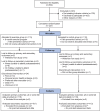Exercise for falls prevention in Parkinson disease: a randomized controlled trial
- PMID: 25552576
- PMCID: PMC4335992
- DOI: 10.1212/WNL.0000000000001155
Exercise for falls prevention in Parkinson disease: a randomized controlled trial
Abstract
Objective: To determine whether falls can be prevented with minimally supervised exercise targeting potentially remediable fall risk factors, i.e., poor balance, reduced leg muscle strength, and freezing of gait, in people with Parkinson disease.
Methods: Two hundred thirty-one people with Parkinson disease were randomized into exercise or usual-care control groups. Exercises were practiced for 40 to 60 minutes, 3 times weekly for 6 months. Primary outcomes were fall rates and proportion of fallers during the intervention period. Secondary outcomes were physical (balance, mobility, freezing of gait, habitual physical activity), psychological (fear of falling, affect), and quality-of-life measures.
Results: There was no significant difference between groups in the rate of falls (incidence rate ratio [IRR] = 0.73, 95% confidence interval [CI] 0.45-1.17, p = 0.18) or proportion of fallers (p = 0.45). Preplanned subgroup analysis revealed a significant interaction for disease severity (p < 0.001). In the lower disease severity subgroup, there were fewer falls in the exercise group compared with controls (IRR = 0.31, 95% CI 0.15-0.62, p < 0.001), while in the higher disease severity subgroup, there was a trend toward more falls in the exercise group (IRR = 1.61, 95% CI 0.86-3.03, p = 0.13). Postintervention, the exercise group scored significantly (p < 0.05) better than controls on the Short Physical Performance Battery, sit-to-stand, fear of falling, affect, and quality of life, after adjusting for baseline performance.
Conclusions: An exercise program targeting balance, leg strength, and freezing of gait did not reduce falls but improved physical and psychological health. Falls were reduced in people with milder disease but not in those with more severe Parkinson disease.
Classification of evidence: This study provides Class III evidence that for patients with Parkinson disease, a minimally supervised exercise program does not reduce fall risk. This study lacked the precision to exclude a moderate reduction or modest increase in fall risk from exercise.
Trial registration: Australian New Zealand Clinical Trials Registry (ACTRN12608000303347).
© 2014 American Academy of Neurology.
Figures


References
-
- Latt MD, Lord SR, Morris JG, Fung VS. Clinical and physiological assessments for elucidating falls risk in Parkinson's disease. Mov Disord 2009;24:1280–1289. - PubMed
-
- Bloem BR, Grimbergen YA, Cramer M. Prospective assessment of falls in Parkinson's disease. J Neurol 2001;248:950–958. - PubMed
-
- Wielinski CL, Erickson-Davis C, Wichmann R, Walde-Douglas M, Parashos SA. Falls and injuries resulting from falls among patients with Parkinson's disease and other parkinsonian syndromes. Mov Disord 2005;20:410–415. - PubMed
-
- Temlett JA, Thompson PD. Reasons for admission to hospital for Parkinson's disease. Intern Med J 2006;36:524–526. - PubMed
Publication types
MeSH terms
Grants and funding
LinkOut - more resources
Full Text Sources
Other Literature Sources
Medical
Research Materials
